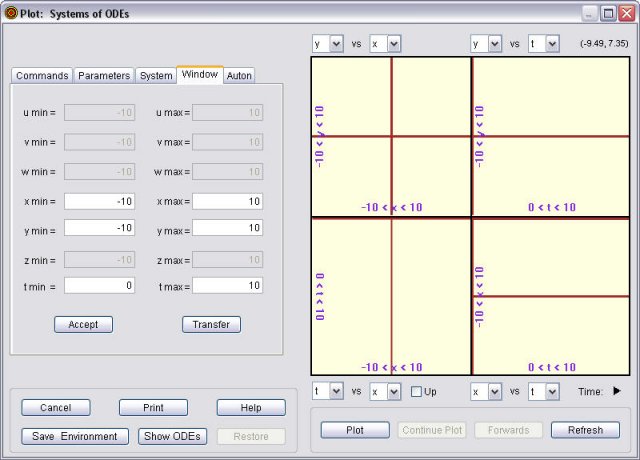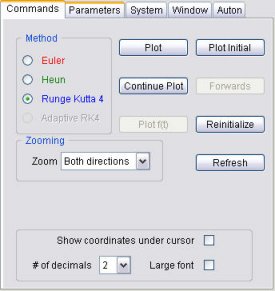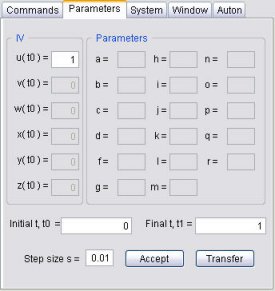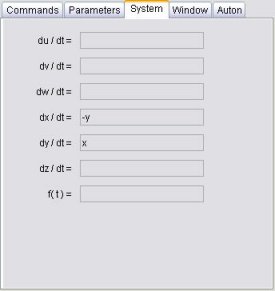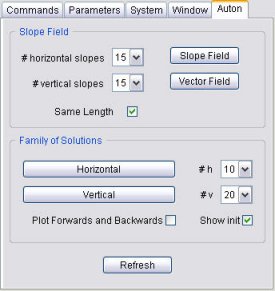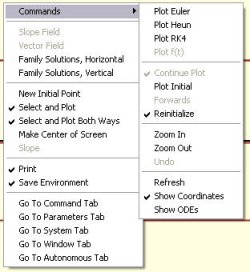The Plot 4 Windows
Clicking on "Plot 4 Windows" in the main window, opens up the Plot 4 Windows, where numerical solutions can be plotted in four Plotting Windows.
The system of ODEs from the "Main Window" is copied and used here. After opening the Plot 4 Windows, any changes made on the Main Window are not updated on the Plot 4 Windows. (This is different from what happens in the Numerics Window).
The Plot 4 Windows
Above the top Plotting Windows, and below the bottom Plotting Windows, you can select the variables that you want to use on the vertical and horizontal axes.
The defaults are, going clockwise starting with the top-left Plotting Window:
- Top-left. Horizontal axis: the first (alphabetical) dependent variable. Vertical axis: the second (alphabetical) dependent variable. So in a system of two ODEs, this would be the phase plane.
- Top-right. Horizontal axis: "t". Vertical axis: the second (alphabetical) dependent variable.
- Bottom-right. Horizontal axis: "t". Vertical axis: the first (alphabetical) dependent variable.
- Bottom-left. Horizontal axis: the first (alphabetical) dependent variable. Vertical axis: "t".
The "Up" checkbox applies to the bottom-left Plotting Window. It is available only if the vertical variable is "t". If it is unchecked (the default), then the plot is drawn from top to bottom. In other words, in the default configuration, the bottom-left Plotting Window is the same as the bottom-right, rotated clockwise by 90 degrees. In this configuration, the label runs from top to bottom. If the "Up" checkbox is checked, then the bottom-left Plotting Window behaves like the other three.
The ODE that is being used here is
dx/dt = -y, dy/dt = x, x(t0) = 5, y(t0) = 0, t0 = 0, t1 = 10,
with s = 0.1. The default Plotting Window configuration for this system is the one shown in the figure, because the first of the dependent variables is "x" and the second is "y".
Below the Plotting Window, and to the right, is "Time" followed by an arrow, in this case pointing to the right. This means that plotting will be "forwards" in time. If the arrow points to the left, then plotting will be "backwards" in time.
To the left of the Plotting Window are various tabs. The one that is exposed is the "Window" tab, which is where the minimum and maximum of each variable's window can be set. The default is -10 to 10 for each variable except "t", which defaults to "t0" and "t1". Note that the minimum and maximum of "t" need not coincide with "t0" and "t1".
The other tabs are
There are 6 buttons at the bottom left of the Plotting Windows.
- "Cancel", which closes the Plot 4 Windows.
- "Print", which allows you to print the Plot 4 Windows to a printer (as long as the window has not been resized), or to a file. Various graphics file types are available: BMP, GIF, JPEG, PNG, TIFF, and WMF.
- "Help", which shows this help file.
- "Save Environment", which saves the existing ODEs (and the graphical environment) to disk with extension "en4". (The environment includes such things as the variables selected for the axes, the maximum and minimum for these variables, and the selected tab.) These are the files that can be loaded later using "Open Environment" under the "Main Window".
- "Show ODEs", which shows the current ODEs, initial values, parameters in use, etc.
- "Restore", which restores the Plot 4 Window to its original size so that printing to a printer can be enabled.
There are 4 buttons at the bottom right of the Plotting Window. These buttons are duplicated in the "Commands" tab.
- "Plot", which plots the numerical solution to the ODE in all Plotting Windows, based on the selection made in "Methods" under the "Commands" Tab. The color of the plot depends on the method selected: Euler in red, Heun in green, and RK4 in blue.
- "Continue Plot", which becomes available after a plot. It continues plotting the numerical solution in all windows using the final values of the variables from the previous plot become the new initial variables of the current plot. It is equivalent to "t1 to t0" on the Numerics Window.
- "Forwards", which is permanently disabled. It is here for consistency with the Plot 1 Window.
- "Refresh", which clears all Plotting Windows.
Calculations cease if the point is well outside the Plotting Window.
When the window is resized, the Plotting Windows are cleared.
Selecting this tab shows many of the commands available for plotting ODEs.
Under "Method" there are four different numerical routines to choose from: Euler's Method, Heun's Method (sometimes called the Modified Euler's Method), Runge Kutta 4, or Adaptive RK4 (adaptive stepsize Runge Kutta 4). (Adaptive RK4 is under construction so is grayed out.)
The buttons available (which apply globally, that is, to all Plotting Windows), are:
- "Plot", which plots the numerical solution to the ODE in the all Plotting Windows, based on the selection made in "Methods". The color of the plot depends on the method selected: Euler in red, Heun in green, and RK4 in blue. This button duplicates the "Plot" button beneath the Plotting Window.
- "Plot Initial", which places a dot at the initial points, if they are on the screen.
- "Continue Plot", which becomes available after a plot. It continues plotting the numerical solution using the final values of the variables from the previous plot become the new initial variables of the current plot. It is equivalent to "t1 to t0" on the Numerics Window. This button duplicates the "Continue Plot" button beneath the Plotting Window.
- "Forwards", which is permanently disabled. It is here for consistency with the Plot 1 Window.
- "Plot f(t)", which uses the current stepsize to plot f(t) in magenta on the Plotting Windows, if a function is defined and if the horizontal variable is "t" in any of the Plotting Windows.
- "Reinitialize", which restores all the values and window sizes to the initial values.
- "Refresh", which clears all Plotting Windows. This button duplicates the "Refresh" button beneath the Plotting Windows.
It is possible to Zoom "In" or Zoom "Out", either "Horizontally", "Vertically", or in "Both Directions" on a particular Plotting Window using its "Context Menu". Zooming can be undone, which also refreshes (clears) its Plotting Window, and any others it impacts.
Checking the "Show Coordinates" box, shows the coordinates as a tooltip under the mouse pointer when the mouse is over the Plotting Windows. The number of decimal points displayed can be set from 1 to 10.
The coordinates under the mouse pointer when the mouse is over any Plotting Window are always displayed in the upper right. The "large Font" box, if checked, shows these coordinates in a larger bold font. The effect is immediate. This option is useful when projecting the screen in a classroom.
Clicking in any Plotting Window when the coordinates are displayed as a tooltip causes that point to become the new center of that Plotting Window, called Translating. This may impact other Plotting Windows. Translating can be undone using "Undo", which also refreshes (clears) the impacted Plotting Windows.
To zoom in or out about a point other than the center of a Plotting Window, click on the point to make it the center of the screen, and then select "In" or "Out" from its "Context Menu".
Selecting this tab shows the initial values of the dependent variables, the parameter values, the initial and final times, and the step size.
Any of these can be changed, after which the "Accept" button should be clicked.
Clicking on "Transfer", copies the values of "t0" and "t1" to "t min" and "t max" under the "Window" Tab.
Selecting this tab shows the current system of ODEs.
These values cannot be edited. To edit any of these values, close the "Plot 4 Windows" and use "Edit" on the "Main Window".
If the system of ODEs is either autonomous (the right-hand side is independent of "t") or if there is only one ODE, then this tab is exposed. Selecting this tab shows more commands grouped under Slope Field and Family of Solutions. These commands, if valid, apply globally, that is, to all Plotting Windows.
Slope Field.
If there is only one ODE, or, in the case of an autonomous system, if "t" is not one of the variables selected in the Plotting Window, then the program will expose the "Slope Field" and "Vector Field" buttons. The number of horizontal and vertical slopes range from 5 to 40. The slopes can be of the same or variable length.
"Slope Field" plots a slope field, while "Vector Field" plots a vector field (also called a direction field). In this case, the slopes have circular heads to indicate the direction of the vector, rather like a tadpole.
Family of Solutions. It is possible to plot a family of solutions (that is, multiple solutions) based on the current initial values and the variables selected for the horizontal and vertical axes.
The result depends on the variables used in the Plotting Windows.
- If all the Plotting Windows have "t" as a horizontal or vertical variable, then, in each window, one of the two variables is kept fixed, while the other's maximum and minimum are divided into an equal number of new initial points. These plots are independent of each other.
- If "t" is absent from one or more of the Plotting Windows, then, starting with the top-left and proceeding clockwise, the first "phase plane" found (that is, the first window where "t" is not a variable) is used as the active window. In this window one of the two variables is kept fixed, while the other's maximum and minimum are divided into an equal number of new initial points. Then the solutions corresponding to each of these initial points is drawn in all the windows.
The plot uses the Method selected under the Commands Tab.
If the "Show init" box is checked, the initial points are shown.
If the "Plot Forwards and Backwards" box is checked, the solutions are plotted both forwards and backwards in time.
While plotting a family of solutions a progress bar and an "Abort" button are exposed, allowing you to stop the calculations at any time.
The original initial values are restored after the plots.
When the mouse is over any of the Plotting Windows, right-clicking reveals a Context Menu specific to that window.
Menu options that are checked apply to all windows, if valid. Unchecked items apply to the Plotting Window associated with the Context Menu.
The Commands to the right, are the same ones that appear under the Commands Tab, but apply to the specific Plotting Window unless checked.
The first group on the left-hand side are the same ones that appear under the Auton Tab, but apply to the specific Plotting Window.
The second group on the left-hand side depend on the position of the mouse pointer when you right-clicked to get the Context Menu.
- "New Initial Point" makes the coordinates under the pointer the new initial point, and plots this point. This menu item is visible if there is only one ODE, or, in the case of an autonomous system, if "t" is not one of the variables selected in the Plotting Window.
- "Select and Plot" makes the coordinates under the pointer the new initial point and then plots both this point and the numerical solution, based on the "Method" selected under the Commands Tab. After plotting to a window in which "t" is not one of the plot variables, the initial times are restored. This menu item is visible if there is only one ODE, or, in the case of an autonomous system, if "t" is not one of the variables selected in the Plotting Window.
- "Select and Plot Both Ways" makes the coordinates under the pointer the new initial point and then plots both this point and the numerical solution forwards and backwards, based on the "Method" selected under the Commands Tab. After plotting to a window in which "t" is not one of the plot variables, the initial times are restored. This menu item is visible if there is only one ODE, or, in the case of an autonomous system, if "t" is not one of the variables selected in the Plotting Window.
- "Make Center of Screen" makes the point under the cursor the new center of the Plotting Window. It is the same as clicking on the Plotting Window if "Show Coordinates" is checked under the Commands Tab. However, here the "Show Coordinates" need not be checked for this to work. "Undo" under the Commands Tab undoes this operation, and clears the screen.
- "Slope" draws a single slope at the pointer. This menu item is visible if there is only one ODE, or, in the case of an autonomous system, if "t" is not one of the variables selected in the Plotting Window.
The menu items in third group are the same as those displayed at the bottom left of the Plot 4 Window.
The final group allows you to rapidly move to one of the tabs.
